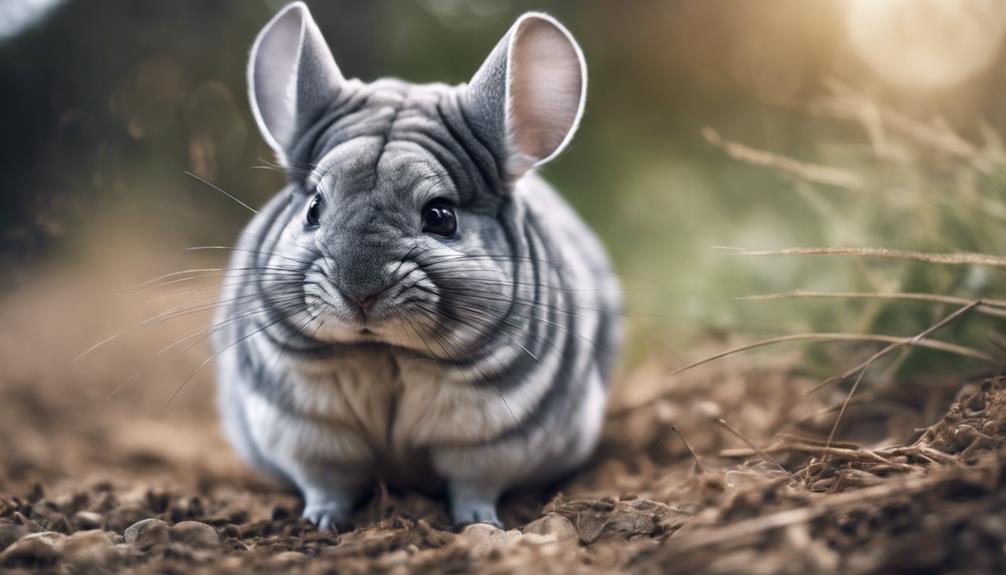Why Are Some Chinchillas More Active During the Day?

Chinchillas are crepuscular animals, meaning they are most active during dawn and dusk. This behavior is influenced by their natural habitat, where they would be most active during these times to avoid predators. Chinchillas may also become more active during the day if they are kept in a well-lit environment or receive attention from their owners during daytime hours.
This flexibility in their activity patterns allows chinchillas to adapt to different environments and schedules, making them versatile pets for those with varying lifestyles.
Natural Circadian Rhythms
Studying chinchilla activity patterns reveals how these nocturnal rodents exhibit natural circadian rhythms that govern their behavior and physiological processes. Chinchillas are known for their distinctive sleep patterns, primarily active during the night and resting during the day. Their sleep-wake cycle is regulated by an internal clock, influencing when they're most alert and active. Despite being nocturnal animals, chinchillas may display some daytime behavior, especially in captive settings where they can adapt to human schedules.
Chinchillas typically engage in short periods of activity throughout the night, with intermittent naps in between. During the day, they tend to rest, groom themselves, and occasionally engage in light play. These daytime behaviors are essential for their overall well-being as they allow chinchillas to conserve energy and recover from their nighttime activities. Understanding these natural circadian rhythms is crucial for providing proper care and enrichment for chinchillas, ensuring they lead healthy and fulfilling lives.
Environmental Influences

The environmental influences on chinchilla activity patterns are multifaceted, with light exposure and temperature playing crucial roles. Light exposure impacts the chinchillas' natural rhythms, influencing their activity levels throughout the day.
Additionally, temperature fluctuations have been observed to affect chinchillas' overall activity, demonstrating the intricate relationship between environmental factors and their behavior.
Light Exposure Impact
Exposure to varying levels of light influences the activity patterns of chinchillas in their natural habitat. The impact of light intensity on chinchilla behavior is significant, leading to observable changes in their daily routines.
Here are four key ways light exposure affects chinchilla activity:
- Daytime Activity: Chinchillas exposed to bright light during the day tend to be more active and engaged in exploration and play.
- Sleep Patterns: Increased light exposure can alter chinchillas' sleep patterns, leading to shorter periods of rest and more frequent awakenings.
- Behavioral Changes: Chinchillas may exhibit altered behaviors such as increased grooming or vocalizations in response to changes in light intensity.
- Circadian Rhythms: Light exposure plays a crucial role in regulating chinchillas' internal clocks, influencing when they're most active during the day.
Temperature Effects on Activity
Light intensity and temperature fluctuations in their environment profoundly impact the activity patterns of chinchillas, influencing various aspects of their daily routines. Chinchillas are sensitive to temperature changes, with high temperatures often leading to decreased activity levels. When temperatures rise, chinchillas tend to become lethargic and may seek out cooler areas to rest.
In contrast, lower temperatures can increase their activity levels as they work to maintain their body heat. These temperature effects can also disrupt their sleep cycle, causing them to adjust their rest periods accordingly. Monitoring and regulating the temperature of chinchilla habitats is crucial to ensuring their comfort and well-being, as it directly impacts their energy levels and overall activity throughout the day.
Health and Well-being Factors

Understanding how health and well-being factors impact chinchilla activity patterns is essential for their overall care and welfare. Several key health and well-being factors can influence a chinchilla's activity levels:
- Stress Factors: Chinchillas can experience stress due to changes in their environment, such as loud noises or sudden movements, leading to decreased activity levels.
- Activity Levels: Illness or pain can significantly impact a chinchilla's activity levels, causing them to be more lethargic during the day.
- Exercise Requirements: Chinchillas require regular exercise to maintain their physical health and mental well-being. Lack of exercise can lead to obesity and decreased activity levels.
- Mental Health: Chinchillas are social animals that thrive on interaction and mental stimulation. Lack of companionship or environmental enrichment can result in decreased activity during the day.
Social Interaction Dynamics

Factors influencing chinchilla activity patterns extend to their social interaction dynamics, which play a crucial role in shaping their behavioral responses within their environment. Chinchillas are social animals that exhibit various group dynamics and bonding activities. Understanding their social hierarchy and play behavior can provide insights into why some chinchillas may be more active during the day than others.
| Social Interaction Dynamics | Description | Importance |
|---|---|---|
| Group Dynamics | Chinchillas thrive in groups and display | Understanding group dynamics helps in |
| social behaviors such as grooming | maintaining their social well-being. | |
| Play Behavior | Play is essential for chinchillas' physical | Engaging in play behavior promotes |
| and mental stimulation, fostering | overall well-being and reduces stress levels. | |
| Social Hierarchy | Chinchillas establish hierarchies within | Recognizing social hierarchy aids in |
| their groups, impacting interactions | understanding their social structure. |
Genetic Predispositions

Chinchilla activity patterns are significantly influenced by genetic predispositions. These genetic factors play a crucial role in shaping the behavioral patterns observed in chinchillas, impacting their activity levels and preferences.
Understanding the genetic basis of chinchilla behavior can provide valuable insights into their natural tendencies and individual differences.
Genetic Influence on Activity
Inherited genetic factors play a significant role in shaping chinchilla activity levels and patterns. Genetic predispositions can influence how active a chinchilla is throughout the day. Here are four ways genetic influence can impact chinchilla activity:
- Energy Levels: Some chinchillas may inherit higher energy levels, leading to increased activity levels.
- Circadian Rhythms: Genetic traits can affect how chinchillas follow their natural sleep-wake cycles, influencing when they're most active.
- Exploratory Behavior: Certain genetic predispositions may make chinchillas more curious and inclined to explore their surroundings, increasing their activity levels.
- Reproductive Drive: Genetic factors can influence mating behaviors, impacting the activity levels of chinchillas during breeding seasons.
Understanding these genetic influences can help chinchilla owners better cater to their pets' needs and behaviors.
Behavioral Patterns in Chinchillas
Genetic predispositions in chinchillas can influence their behavioral patterns, shaping how they interact with their environment and engage in various activities. Chinchillas are known for their playful tendencies, which can be attributed to genetic factors that drive their curiosity and social interactions. Additionally, chinchillas typically exhibit nocturnal habits, being more active during the night and resting during the day.
These nocturnal behaviors have evolutionary roots and are deeply ingrained in their genetic makeup. Understanding these genetic predispositions is crucial for providing appropriate care and enrichment for chinchillas in captivity. By recognizing and accommodating their natural behavioral patterns, chinchilla owners can ensure the overall well-being and happiness of these adorable and energetic creatures.
Age and Developmental Stage

During different stages of their development, chinchillas exhibit varying activity patterns that are influenced by their age and maturation level. Understanding these changes can help chinchilla owners provide suitable care and meet their pets' needs effectively.
- Early Life: Young chinchillas, especially kits under six months old, are typically more energetic and playful as they explore their surroundings and develop their coordination skills.
- Adolescence: During this period, chinchillas may start exhibiting more independent behaviors and may be more active during the night as they establish their own routines.
- Adult Stage: Adult chinchillas generally have more consistent daily routines, being active during dusk and dawn, which can vary slightly depending on the individual.
- Senior Chinchillas: As chinchillas age, they may start to slow down, becoming less active and spending more time resting or engaging in low-energy activities.
Diet and Nutritional Considerations

Chinchilla activity patterns are closely linked to their diet and nutritional considerations, playing a significant role in their overall health and well-being. Feeding habits directly impact a chinchilla's metabolic rate, affecting how active they're during the day. Chinchillas are herbivores with specific dietary requirements, needing a high-fiber diet to maintain proper gut health and digestion. The quality and quantity of food provided can influence their energy levels and overall behavior.
Nutrient absorption is crucial for chinchillas to thrive. A balanced diet rich in essential vitamins and minerals is essential for their well-being. Poor nutrition can lead to deficiencies that may manifest as lethargy or decreased activity levels. Chinchillas require a diet that supports their high metabolic rate, providing them with the energy needed to be active and engaged during the day.
Understanding chinchillas' dietary needs and ensuring they receive proper nutrition is vital for promoting their activity levels and overall health. By monitoring their feeding habits and providing a well-rounded diet, chinchilla owners can support their pets in leading active and healthy lives.
Frequently Asked Questions
How Can I Train My Chinchilla to Be More Active During the Day?
When training a chinchilla to be more active during the day, it's essential to establish a consistent activity schedule, implement behavioral training techniques, consider diet changes, and incorporate exercise routines to promote their physical and mental well-being.
Are There Any Supplements or Medications That Can Help Increase a Chinchilla's Daytime Activity Levels?
Diet adjustments, behavioral training, natural remedies, and exercise routines can help increase a chinchilla's daytime activity levels. Consulting a veterinarian for tailored advice is crucial to ensure the chinchilla's wellbeing and promote a healthy lifestyle.
Can Changing the Lighting in My Chinchilla's Cage Affect Their Activity Patterns?
Changing the lighting in a chinchilla's cage can impact their activity patterns. Natural vs artificial light influences their circadian rhythm. Disruption can lead to altered behavior. Maintaining a consistent lighting schedule mimicking their natural environment is essential for their well-being.
Are There Specific Types of Toys or Activities That Can Help Stimulate a Chinchilla to Be More Active During the Day?
Want to keep your chinchilla active during the day? Enrichment toys and exercise wheels offer mental and physical stimulation. Regular playtime and socialization are also crucial for their overall well-being and activity levels.
How Can I Tell if My Chinchilla's Increased Daytime Activity Is a Sign of a Health Issue Rather Than Just a Natural Behavior Change?
Increased daytime activity in chinchillas can indicate behavioral changes or health concerns. Monitoring environmental factors and activity levels is crucial. Sudden shifts may signal underlying issues, prompting a visit to the vet for proper evaluation and care.











